The global marine fin stabilizer market is projected to grow from USD 10.4 billion in 2025 to approximately USD 32.3 billion by 2035, recording an absolute increase of USD 4.3 billion over the forecast period. This translates into a total growth of 179.2%, with the market forecast to expand at a compound annual growth rate (CAGR) of 12.1% between 2025 and 2035.
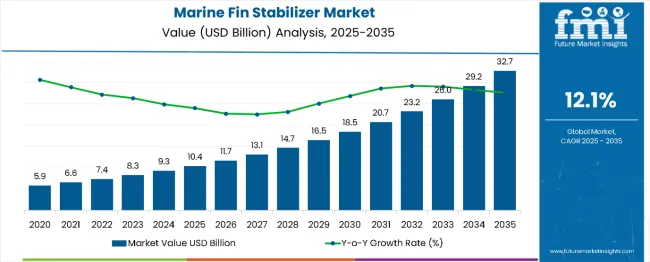
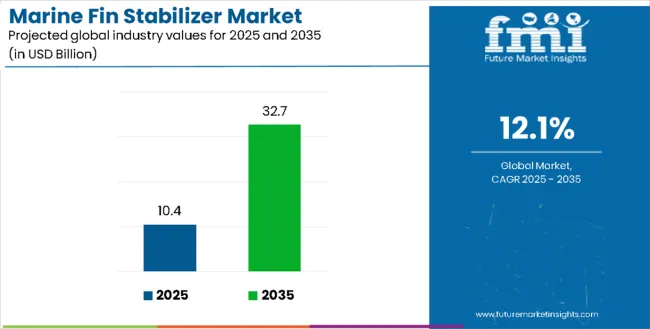
Marine Fin Stabilizer Market Key Takeaways
| Metric | Value |
|---|---|
| Estimated Value in (2025E) | USD 10.4 billion |
| Forecast Value in (2035F) | USD 32.3 billion |
| Forecast CAGR (2025 to 2035) | 12.1% |
The overall market size is expected to grow by nearly 2.79X during the same period, supported by increasing demand for vessel stability systems, rising focus on passenger comfort, and growing maritime trade activities worldwide.
Between 2025 and 2030, the marine fin stabilizer market is projected to expand from USD 10.4 billion to USD 4.1 billion, resulting in a value increase of USD 1.7 billion, which represents 39.5% of the total forecast growth for the decade.
This phase of growth will be shaped by rising demand for advanced vessel stability systems, increasing focus on passenger comfort and safety, and growing adoption of active fin stabilizer technologies in commercial and military vessels. Marine equipment manufacturers are expanding their fin stabilizer product portfolios to address the growing demand for efficient roll reduction solutions.
From 2030 to 2035, the market is forecast to grow from USD 4.1 billion to USD 32.3 billion, adding another USD 2.6 billion, which constitutes 60.5% of the overall ten-year expansion. This period is expected to be characterized by expansion of smart stabilization systems, integration of IoT and automation technologies in marine applications, and development of energy-efficient fin stabilizer solutions.
The growing adoption of advanced vessel designs and increasing focus on fuel efficiency will drive demand for premium fin stabilizers with enhanced performance and automated control systems.
Between 2020 and 2025, the marine fin stabilizer market experienced steady expansion, driven by increasing global maritime trade and growing demand for passenger vessel comfort. The market developed as shipbuilders and vessel operators recognized the need for effective roll stabilization systems to improve vessel performance and passenger experience. Technological advancements in active fin stabilizer systems and growing focus on vessel safety regulations began emphasizing the importance of advanced stabilization systems in modern vessel design.
Market expansion is being supported by the increasing demand for enhanced vessel stability and passenger comfort across commercial and military maritime applications. Modern vessel operators are increasingly focused on improving operational efficiency and reducing motion-induced fatigue for crew and passengers. Marine fin stabilizers' proven efficacy in reducing vessel roll motion and improving overall stability makes them essential equipment for modern vessels operating in challenging sea conditions.
The growing emphasis on advanced marine technologies and automated vessel systems is driving demand for sophisticated fin stabilizer solutions with integrated control systems. Vessel operators' preference for multifunctional stabilization systems that combine roll reduction with improved fuel efficiency and vessel maneuverability is creating opportunities for innovative technologies. The rising influence of maritime safety regulations and vessel comfort standards is also contributing to increased product adoption across different vessel types and operational profiles.
The market is segmented by product type, application, vessel size, technology, and region. By product type, the market is divided into retractable fin stabilizers and non-retractable fin stabilizers. Based on application, the market is categorized into passenger vessels, merchant vessels, navy and coast guard vessels, and fishing vessels.
In terms of vessel size, the market is segmented into large vessels (>100m), medium vessels (50-100m), and small vessels (<50m). By technology, the market is classified into active fin stabilizers and passive fin stabilizers. Regionally, the market is divided into North America, Europe, East Asia, South Asia & Pacific, Latin America, and Middle East & Africa.
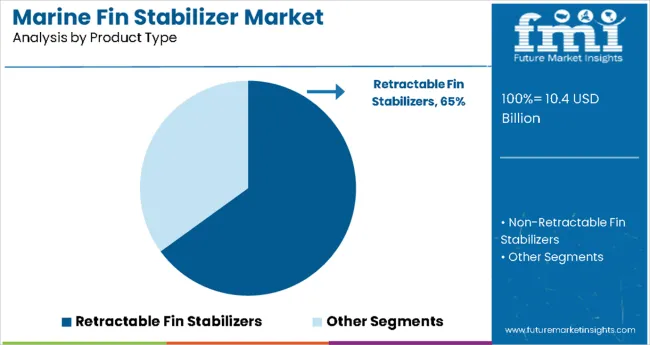
The retractable fin stabilizers segment is projected to account for 65.0% of the marine fin stabilizer market in 2025, reaffirming its position as the preferred stabilization solution. Vessel operators increasingly understand the advantages of retractable systems, including reduced drag during high-speed operations, protection from damage during docking, and improved fuel efficiency. Retractable fin stabilizers' ability to extend and retract based on operational requirements directly addresses concerns about vessel performance optimization and operational flexibility.
This product type forms the foundation of most premium vessel stabilization systems, as it represents the most advanced and operationally efficient solution available. Marine engineering endorsements and ongoing technological improvements continue to strengthen confidence in retractable fin stabilizer systems. With vessel operators focusing on maximizing operational efficiency while maintaining superior stability performance, retractable systems align with both performance and economic operational goals. Their broad appeal across commercial and military applications ensures sustained dominance, making them the central growth driver of marine fin stabilizer demand.
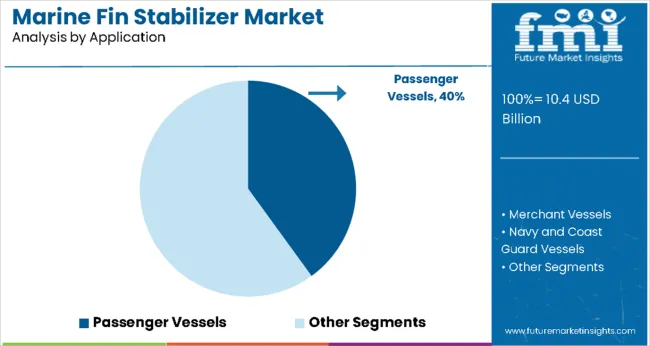
Passenger vessels are projected to represent 40.0% of marine fin stabilizer demand in 2025, underscoring their role as the primary application segment for advanced stabilization systems. Vessel operators prioritize passenger comfort and safety, making fin stabilizers essential equipment for cruise ships, ferries, and other passenger-carrying vessels.
Positioned as critical safety and comfort equipment, fin stabilizers offer both operational benefits, such as reducing motion sickness and improving passenger experience, and commercial benefits, including enhanced vessel reputation and customer satisfaction.
The segment is supported by the growing global cruise industry and increasing demand for luxury passenger vessel experiences. Additionally, maritime regulations are increasingly requiring advanced stability systems for passenger vessels, enhancing the mandatory adoption of fin stabilizer technologies.
As passenger vessel operators prioritize comfort, safety, and operational excellence, marine fin stabilizers will continue to dominate this application segment, reinforcing their essential positioning within the passenger maritime market.
The marine fin stabilizer market is advancing rapidly due to increasing focus on vessel stability and passenger comfort, along with growing demand for advanced maritime technologies. However, the market faces challenges including high installation costs, maintenance complexity, and competition from alternative stabilization systems. Innovation in active control systems and energy-efficient technologies continue to influence product development and market expansion patterns.
Expansion of Smart Stabilization Systems and Automation Technologies
The growing adoption of IoT and smart technologies is enabling vessel operators to implement automated stabilization systems with real-time performance monitoring. Advanced control systems offer precise stabilization adjustments, predictive maintenance capabilities, and integration with vessel management systems. Digital connectivity and automated operation are driving system adoption, particularly among operators who prefer advanced technological solutions for enhanced vessel performance.
Integration of Energy-Efficient Technologies and Sustainable Operation
Modern marine fin stabilizer manufacturers are incorporating energy-efficient drive systems, regenerative technologies, and optimized control algorithms to reduce power consumption and environmental impact. These technologies improve operational efficiency while reducing fuel consumption and extending system service life, providing better return on investment. Advanced engineering techniques also enable hybrid stabilization systems that combine fin stabilizers with other stability technologies for optimal performance across different operating conditions.
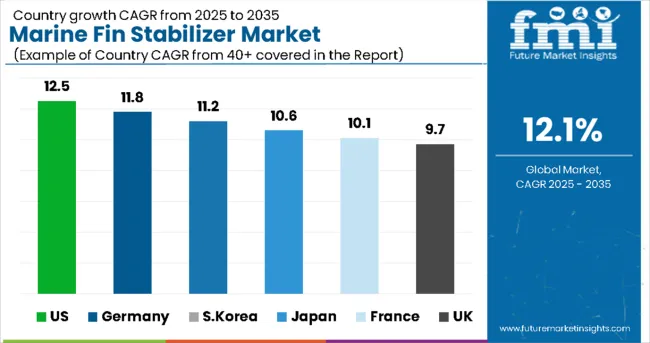
| Country | CAGR (2025 to 2035) |
|---|---|
| United States | 12.5% |
| Germany | 11.8% |
| South Korea | 11.2% |
| Japan | 10.6% |
| France | 10.1% |
| UK | 9.7% |
| Brazil | 9.1% |
The marine fin stabilizer market is experiencing robust growth globally, with the United States leading at a 12.5% CAGR through 2035, driven by strong maritime industry, increasing cruise vessel operations, and growing focus on vessel comfort and safety systems. Germany follows closely at 11.8%, supported by advanced marine engineering capabilities, established shipbuilding industry, and increasing demand for premium stabilization technologies.
South Korea shows strong growth at 11.2%, emphasizing technological innovation and expanding commercial vessel construction. Japan records 10.6%, focusing on advanced marine technologies and high-quality stabilization systems. France shows 10.1% growth, prioritizing naval applications and luxury vessel markets. The UK demonstrates 9.7% growth, emphasizing maritime heritage and advanced naval technologies.
The report covers an in-depth analysis of 40+ countries; seven top-performing countries are highlighted below.
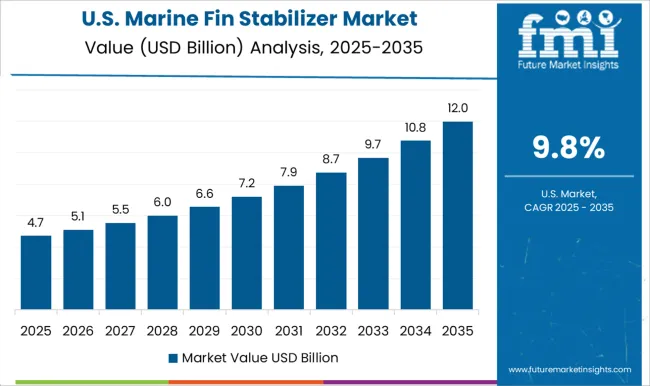
Revenue from marine fin stabilizers in the United States is projected to exhibit strong growth with a CAGR of 12.5% through 2035, driven by robust cruise industry, growing focus on vessel comfort, and increasing adoption of advanced maritime technologies.
The country's extensive coastline and major maritime operations are creating significant demand for premium stabilization systems across commercial and military vessel applications. Major marine equipment manufacturers and shipbuilders are establishing comprehensive service networks to serve the growing population of vessel operators requiring advanced stability solutions.
Revenue from marine fin stabilizers in Germany is expanding at a CAGR of 11.8%, supported by advanced marine engineering capabilities, established shipbuilding industry, and rising demand for premium stabilization technologies.
The country's strong maritime heritage and focus on technological innovation are driving demand for sophisticated fin stabilizer solutions across commercial and naval applications. German marine equipment manufacturers and engineering companies are developing advanced stabilization systems to serve both domestic and international maritime markets.
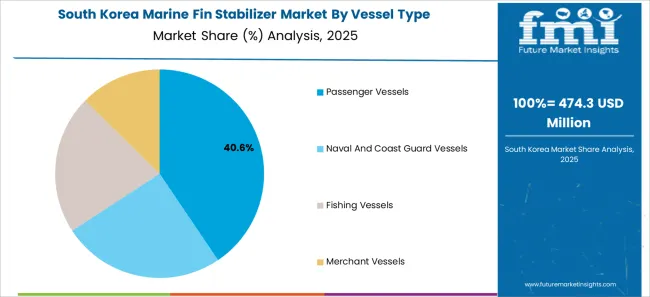
Demand for marine fin stabilizers in South Korea is projected to grow at a CAGR of 11.2%, supported by advanced shipbuilding capabilities, technological innovation focus, and growing commercial vessel construction activities.
South Korean shipbuilders are increasingly integrating sophisticated stabilization systems into new vessel designs, driven by customer demand for enhanced performance and comfort. The market is characterized by strong demand for technologically advanced systems that combine stabilization with vessel automation and control systems.
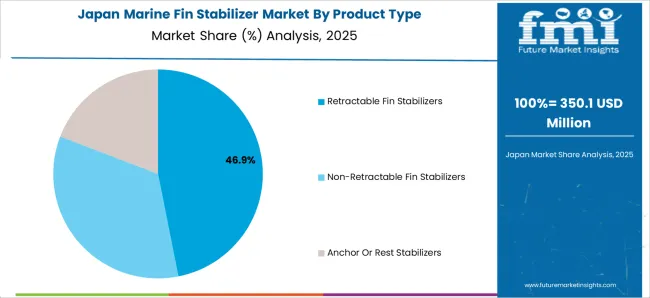
Revenue from marine fin stabilizers in Japan is projected to grow at a CAGR of 10.6% through 2035, driven by the country's strong focus on marine technology innovation, premium vessel construction, and emphasis on advanced automated systems. Japanese vessel operators consistently demand high-quality, reliable stabilization systems that deliver superior performance while maintaining operational efficiency and safety.
Revenue from marine fin stabilizers in France is projected to grow at a CAGR of 10.1% through 2035, supported by strong naval shipbuilding heritage, luxury yacht market, and focus on advanced maritime technologies. French vessel operators and shipbuilders value technological excellence, performance reliability, and integration capabilities, positioning advanced fin stabilizers as essential equipment for premium maritime applications.
United Kingdom Anchors Growth with Maritime Heritage and Advanced Technologies
Revenue from marine fin stabilizers in the UK is projected to grow at a CAGR of 9.7% through 2035, supported by the country's strong maritime heritage, advanced naval technologies, and focus on vessel performance optimization. British vessel operators prioritize proven reliability, advanced functionality, and integration with vessel systems, making sophisticated fin stabilizers a preferred choice for premium maritime applications.
Revenue from marine fin stabilizers in Brazil is projected to expand at a 9.1% CAGR in the marine fin stabilizer market through 2035, driven by the modernization of its naval fleet, rising demand for offshore support vessels in the oil and gas sector, and growing adoption of stabilizer systems in regional passenger and coastal vessels.
Government investments in maritime infrastructure, combined with increasing safety requirements for crew operations in rough waters, are further supporting the adoption of advanced stabilization technologies. Additionally, Brazil’s emerging yacht and leisure boating segment, particularly along its extensive coastline, is expected to create new opportunities for both retractable and fully electric fin stabilizers over the forecast period.
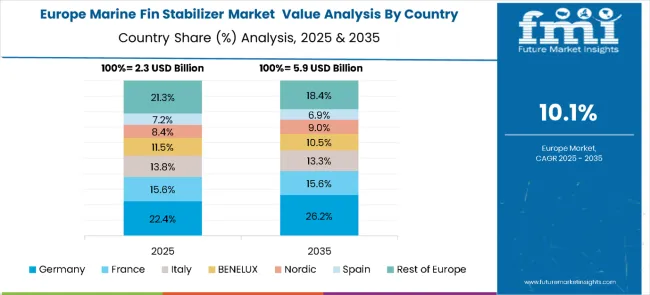
The marine fin stabilizer market in Europe is projected to expand steadily through 2035, supported by strong cruise ship demand, growth in the luxury yacht sector, and continued modernization of merchant and naval fleets. Germany will remain the largest market, accounting for 27.0% of Europe’s share in 2025, with growth at a CAGR of 10.9% through 2035, driven by its robust shipbuilding base, leadership in compact and high-performance stabilizer solutions, and significant retrofit adoption.
The United Kingdom follows with around 20.0% share, supported by its strong luxury yacht and superyacht ownership base, rising retrofit activity, and growing shift toward fully retractable and electric stabilizers. France contributes about 17.5%, backed by its passenger vessel construction programs and increasing integration of AI-enabled stabilization systems for both municipal and tourism-driven fleets. Italy represents roughly 15.0%, anchored by its dominance in yacht and superyacht manufacturing, with leading domestic players such as CMC Marine advancing innovations in lightweight and electric retractable stabilizers.
Spain holds close to 10.5%, with demand led by coastal tourism, ferry modernization, and cruise vessel upgrades in Mediterranean waters. The Rest of Europe including Nordic, BENELUX, and Eastern European markets collectively captures 10.0%, supported by EU-backed fleet modernization programs, growing naval and coast guard demand, and adoption of noise-reducing stabilizers across smaller passenger and fishing vessels.
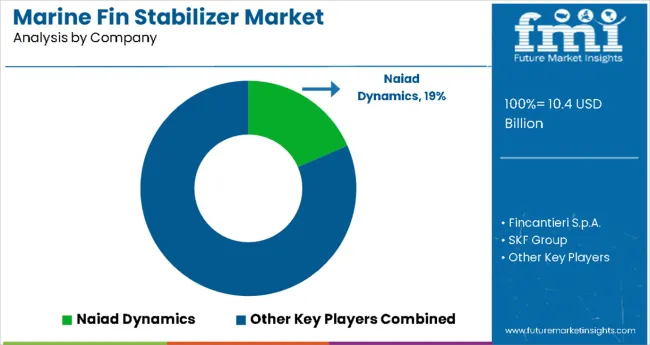
The marine fin stabilizer market is characterized by competition among established marine equipment manufacturers, specialized stabilization system providers, and emerging technology companies. Companies are investing in advanced control technologies, energy-efficient systems, comprehensive service networks, and digital integration capabilities to deliver effective, reliable, and technologically advanced stabilization solutions. Product innovation, system integration capabilities, and global service networks are central to strengthening market presence and competitive positioning.
Naiad Dynamics leads the market with 18.5% global value share, offering advanced fin stabilizer systems with focus on active control technologies and vessel integration capabilities. Fincantieri S.p.A. provides comprehensive marine solutions including integrated stabilization systems with emphasis on shipbuilding integration and performance optimization. SKF Group delivers precision-engineered stabilization components and systems with focus on reliability and maintenance efficiency. Quantum Marine Stabilizers focuses on innovative stabilization technologies with advanced control systems and energy-efficient operation.
Imtra Corp. and Kongsberg Maritime, operating globally, provide comprehensive marine equipment solutions including fin stabilizer systems across multiple vessel applications and operational profiles. Seakeeper Inc. emphasizes gyroscopic stabilization technologies with premium positioning and innovative approaches to vessel stability. CMC Marine offers specialized stabilization solutions with focus on luxury yacht and commercial vessel applications. Western Marine Electronics and Praxis Automation Technology provide advanced control systems and automation solutions for integrated vessel stabilization applications.
The success of marine fin stabilizers, driven by demand for passenger comfort, naval modernization, and fuel efficiency improvements, will not only enhance maritime safety but also strengthen sustainability in global shipping. It will consolidate emerging shipbuilding hubs as suppliers of advanced stabilizer systems while aligning advanced economies with ESG-linked marine technologies. This calls for a concerted effort by all stakeholders: governments, industry bodies, suppliers, OEMs, and investors. Each can be a crucial enabler in preparing the market for its next phase of growth.
How Governments Could Spur Local Production and Adoption?
How Industry Bodies Could Support Market Development?
How OEMs and Tech Players Could Strengthen the Ecosystem?
How Suppliers Could Navigate the Shift?
How Investors Could Catalyze Growth?
| Items | Values |
|---|---|
| Quantitative Units (2025) | USD 10.4 Billion |
| Product Type | Retractable Fin Stabilizers, Non-Retractable Fin Stabilizers |
| Application | Passenger Vessels, Merchant Vessels, Navy and Coast Guard Vessels, Fishing Vessels |
| Vessel Size | Large Vessels (>100m), Medium Vessels (50-100m), Small Vessels (<50m) |
| Technology | Active Fin Stabilizers, Passive Fin Stabilizers |
| Regions Covered | North America, Europe, East Asia, South Asia & Pacific, Latin America, Middle East & Africa |
| Countries Covered | United States, Canada, United Kingdom, Germany, France, China, Japan, South Korea, India, Brazil, Australia and 40+ countries |
| Key Companies Profiled | Naiad Dynamics, Fincantieri S.p.A., SKF Group, Quantum Marine Stabilizers, Imtra Corp., Kongsberg Maritime, Seakeeper Inc., CMC Marine, Western Marine Electronics, and Praxis Automation Technology |
| Additional Attributes | Dollar sales by fin stabilizer type and vessel application, regional demand trends, competitive landscape, buyer preferences for active versus passive systems, integration with vessel automation systems, innovations in control algorithms, energy efficiency improvements, and smart stabilization technologies |
North America
Europe
East Asia
South Asia & Pacific
Latin America
Middle East & Africa
The global marine fin stabilizer market is estimated to be valued at USD 10.4 billion in 2025.
The market size for the marine fin stabilizer market is projected to reach USD 31.0 billion by 2035.
The marine fin stabilizer market is expected to grow at a 11.5% CAGR between 2025 and 2035.
The key product types in marine fin stabilizer market are retractable fin stabilizers, non-retractable fin stabilizers and anchor or rest stabilizers.
In terms of vessel type, passenger vessels segment to command 39.2% share in the marine fin stabilizer market in 2025.






Full Research Suite comprises of:
Market outlook & trends analysis
Interviews & case studies
Strategic recommendations
Vendor profiles & capabilities analysis
5-year forecasts
8 regions and 60+ country-level data splits
Market segment data splits
12 months of continuous data updates
DELIVERED AS:
PDF EXCEL ONLINE
Japan Marine Fin Stabilizer Market Analysis by Product, Vessel, Fit Type and Region: A Forecast for 2025 and 2035
Korea Marine Fin Stabilizer Market Trend Analysis Based on Product, Vessel, Fit and, Provinces From 2025 to 2035
Western Europe Marine Fin Stabilizer Market Segmentation based on Product, Vessel, Fit type and Region: A Forecast for 2025 and 2035
Marine Electronics Market Size and Share Forecast Outlook 2025 to 2035
Marine Toxin Market Size and Share Forecast and Outlook 2025 to 2035
Marine Thermal Fluid Heaters Market Size and Share Forecast Outlook 2025 to 2035
Marine Nutraceutical Market Size and Share Forecast Outlook 2025 to 2035
Marine Power Battery System Market Size and Share Forecast Outlook 2025 to 2035
Marine Life Raft Market Size and Share Forecast Outlook 2025 to 2035
Marine Trenchers Market Size and Share Forecast Outlook 2025 to 2035
Marine Electronics Tester Market Size and Share Forecast Outlook 2025 to 2035
Marine Steering Systems Market Size and Share Forecast Outlook 2025 to 2035
Marine & Dock Gangways Market Size and Share Forecast Outlook 2025 to 2035
Marine HVAC System Market Size and Share Forecast Outlook 2025 to 2035
Marine Outboard Engines Market Size and Share Forecast Outlook 2025 to 2035
Marine Fuel Injection System Market Size and Share Forecast Outlook 2025 to 2035
Marine Energy Market Size and Share Forecast Outlook 2025 to 2035
Marine Propulsion Engine Market Size and Share Forecast Outlook 2025 to 2035
Marine Protein Hydrolysate Market Size and Share Forecast Outlook 2025 to 2035
Marine Extract Market Size and Share Forecast Outlook 2025 to 2035

Thank you!
You will receive an email from our Business Development Manager. Please be sure to check your SPAM/JUNK folder too.
Chat With
MaRIA